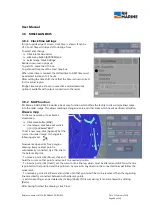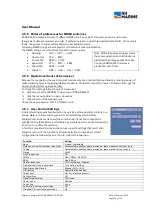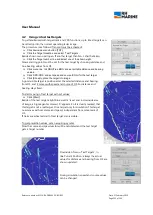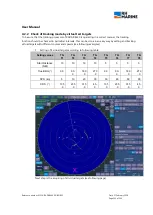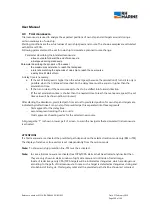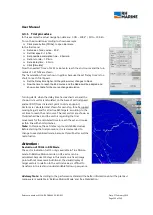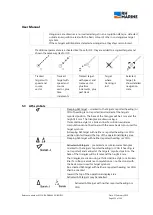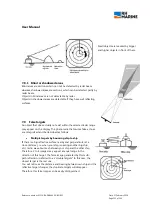
User Manual
Reference number: 4111A-RADAR4600-GBD-R1.1
Date: 27 February 2018
Page 109 of 149
4.3.1
Trial procedure
In this example the actual navigation data are: COG – 308,9° / SOG – 10.0 kn..
To run the simulation according to shown example:
Click menu button [TRIAL], to open trial menu
In the trial menu:
Set value of end course
– 45.6°
Set trial speed
– 16.7kn
Set possible acceleration time - 2.5kn/min
Set a turn rate
– 10°/min
Set a delay time
– 2.1min
Click [Simulate]
Now the needed ‘Time’ of 12:11 minutes to reach the end course and the turn
radius of 1.67 NM are shown.
The ‘Acceleration Time’ is shown in yellow, because the set ‘Delay time’ is too
short, to reach Trial Speed.
Set the Delay time higher, till the yellow colour changes to black.
Now the time to reach the End course and the Radius will be adapted and
show correct data for the course change simulation.
Turning starts, when the delay time has reached cero and the
shown circle vector is calculated on the base of set trial speed
and set ROT (from circle start point to circle endpoint).
Vectors are calculated and shown for own ship, for all acquired
moving targets and for all active AIS targets, according to the
set time to reach the end course. The real vectors are shown as
thick dashed lines, and the vectors regarding the trial
movement for the calculated time to reach the set end course
as thin line with shorter dashes.
Note:
In this case, the set data are ground stabilized values.
Before starting the trial procedure, it is recommended to
change to sea stabilized mode, because this will better suit the
real situation.
Attention:
Restriction of TRIAL in RM Mode
The vector indication for OS only is available in True Motion
mode. In Relative Motion mode no OS vector can be
calculated, because OS stays in this mode on a fixed image
point without movement. Additional, the visual display of
target vectors in relation to the set trial values is difficult to
transform into a real and understandable follow up sequence.
Advisory Note:
According to the performance standard the better information about the planned
manoeuvre is available in 'Relative Motion Mode' and 'Sea Stabilisation'.




